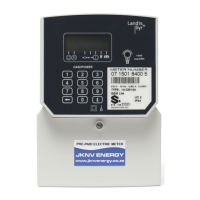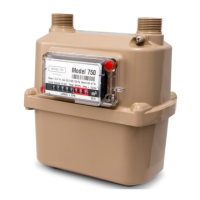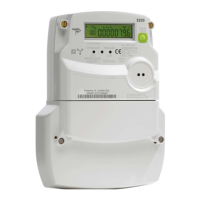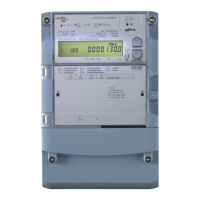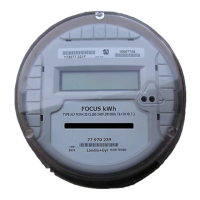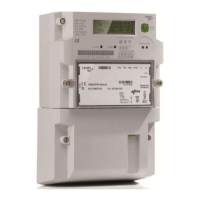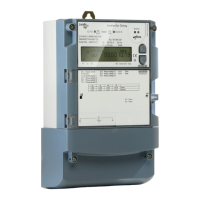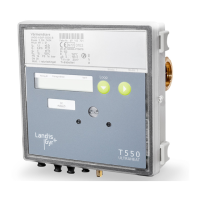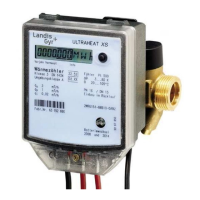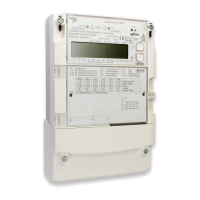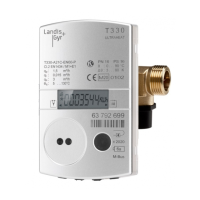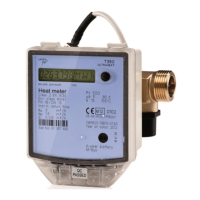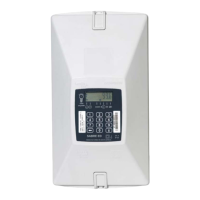
Do you have a question about the Landis+Gyr CASHPOWER SABRE MK 5 and is the answer not in the manual?
| Device Type | Electricity Meter |
|---|---|
| Technology | Electronic |
| Model | CASHPOWER SABRE MK 5 |
| Manufacturer | Landis+Gyr |
| Rated Voltage | 230V |
| Frequency | 50Hz |
| Display Type | LCD |
| Accuracy Class | Class 1 |
| Current Rating | 5-80A |
| Communication | PLC |
| Standards | IEC 62052-11, IEC 62053-21 |
Details the 12-key keypad for voucher entry and accessing information registers.
Explains the function of the LCD, displaying credit, entries, and information.
Describes the red LED indicating metrological accuracy and power consumption rate.
Details the labels on the meter showing serial number, type, and specifications.
Explains the use of sealing clips to secure the meter to its base and indicate tampering.
Explains the pictograms and numerical display blocks on the LCD screen.
Shows common LCD screen displays for normal operation, low credit, and lockouts.
Describes the use of happy/sad face icons for indicating good/bad status or errors.
Explains the icons that show the status of the internal load-switch (closed or open).
Details the 'i' icon indicating when the meter is in information mode.
Explains the 'W' icon indicating instantaneous power or power limit settings.
Describes the 'kWh' icon indicating power consumption or load status.
Explains the 'credit wedge' icons showing remaining credit levels.
Describes the alarm indicator for low credit warnings.
Provides an overview of the meter's features and prepayment functionality.
Details the various indications shown on the LCD during normal meter operation.
Explains the process of entering credit vouchers using the meter's keypad.
Describes how the meter processes entered credit vouchers and displays results.
Explains the meter's response to an incomplete voucher entry, including timeouts.
Details the meter's actions and display sequences after a complete voucher is entered.
Describes the display when a voucher is successfully accepted by the meter.
Explains the display for key change transactions using specific vouchers.
Details the display when a voucher is rejected by the meter.
Describes the display for rejected duplicate vouchers.
Explains the display for rejected expired vouchers.
Describes the display when a voucher is rejected due to credit overflow.
Covers how the meter decrypts and processes various types of STS vouchers.
Details the function of electricity credit vouchers for adding credit.
Explains the use of vouchers for setting the first dispenser key for security.
Describes the use of vouchers for setting the second dispenser key for security.
Explains how to use a voucher to clear tamper conditions.
Details how to use a voucher to set the meter's power limit.
Explains vouchers for setting low and high credit alarm levels.
Describes the function of a voucher that clears credit and opens the load switch.
Details non-meter specific vouchers used to test meter functions.
Explains the use of a proprietary voucher for meter commissioning.
Describes meter-specific vouchers for commissioning.
Explains vouchers used to decommission the meter.
Details vouchers for setting meter options via the 'Changeable Options Register'.
Covers the process of setting the meter into commissioned or decommissioned states.
Explains the power limiting feature and its implementation.
Details how the load switch can be reconnected automatically or manually.
Explains the option to disconnect the load when a power failure occurs.
Describes the various physical and electronic features designed to prevent tampering.
Provides a general overview of the meter's anti-tamper mechanisms and seals.
Details the mechanical anti-tamper switch and its detection capabilities.
Explains the Significant Reverse Energy (SRE) detection feature.
Describes the meter's magnetic tamper detector and its response.
Explains the procedure for resetting a detected tamper condition.
Describes the rear VTC port for accessing meter data during electronics failure.
Details how to view the unique meter identity number.
Explains how to view the currently consumed power.
Describes how to view the meter's current credit balance.
Explains how to view the total kWh consumed since installation.
Details how to view the total credit entered into the meter via tokens.
Describes how to view consumption data for the current 30-day period.
Explains how to view consumption data for the previous 30-day period.
Details how to view the low credit level setting.
Explains how to view the high credit level setting.
Describes how to view the meter's power limit level.
Details the upper bits of the meter state register for status indications.
Details the lower bits of the meter state register for status indications.
Explains the fixed option register, set at manufacture.
Details the changeable option register, configurable via tokens.
Describes the upper bits of the volatile meter state register.
Details the lower bits of the volatile meter state register.
Explains how to view the meter's software version number.
Describes the counter for power failures since installation.
Details the last Credit Transfer Number and Token Identifier.
Explains how to view the Token Identifier for the last credit token.
Describes the value (kWh) of the last credit transfer number entered.
Details the key revision and type, referring to STS specification.
Explains the tariff index, referring to STS specification.
Shows credit register value with 0.01kWh resolution.
Details the initial SGC value and indication of key-change.
Shows total kWh consumed with 0.01kWh resolution.
Explains how to enter and use the customer information mode.
